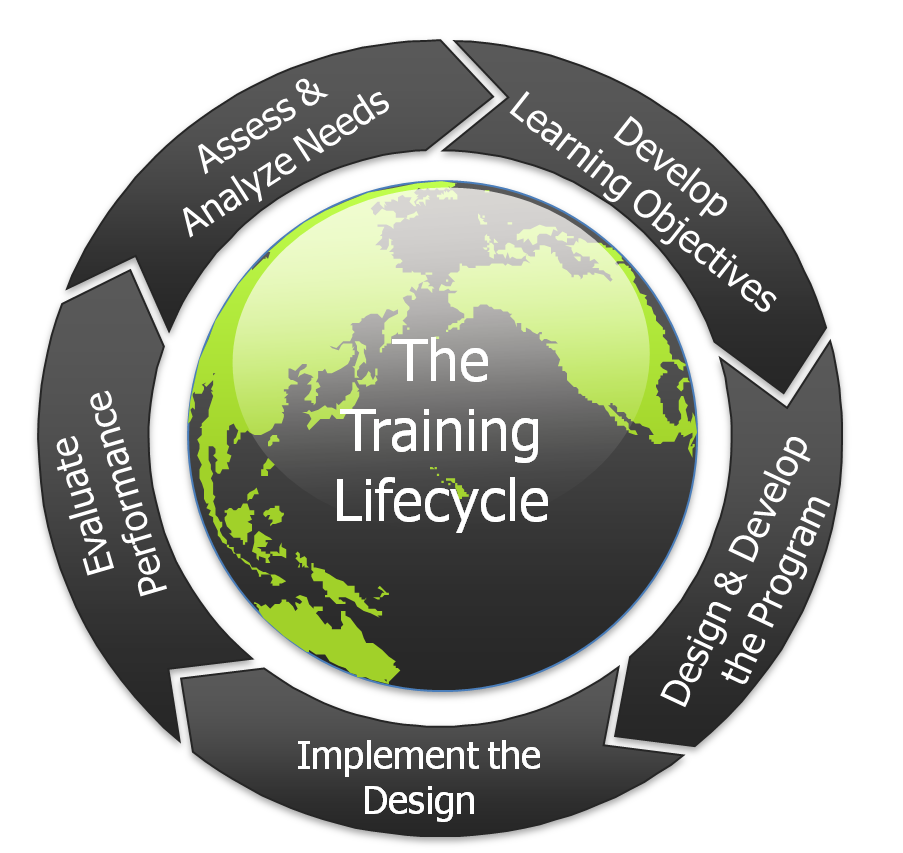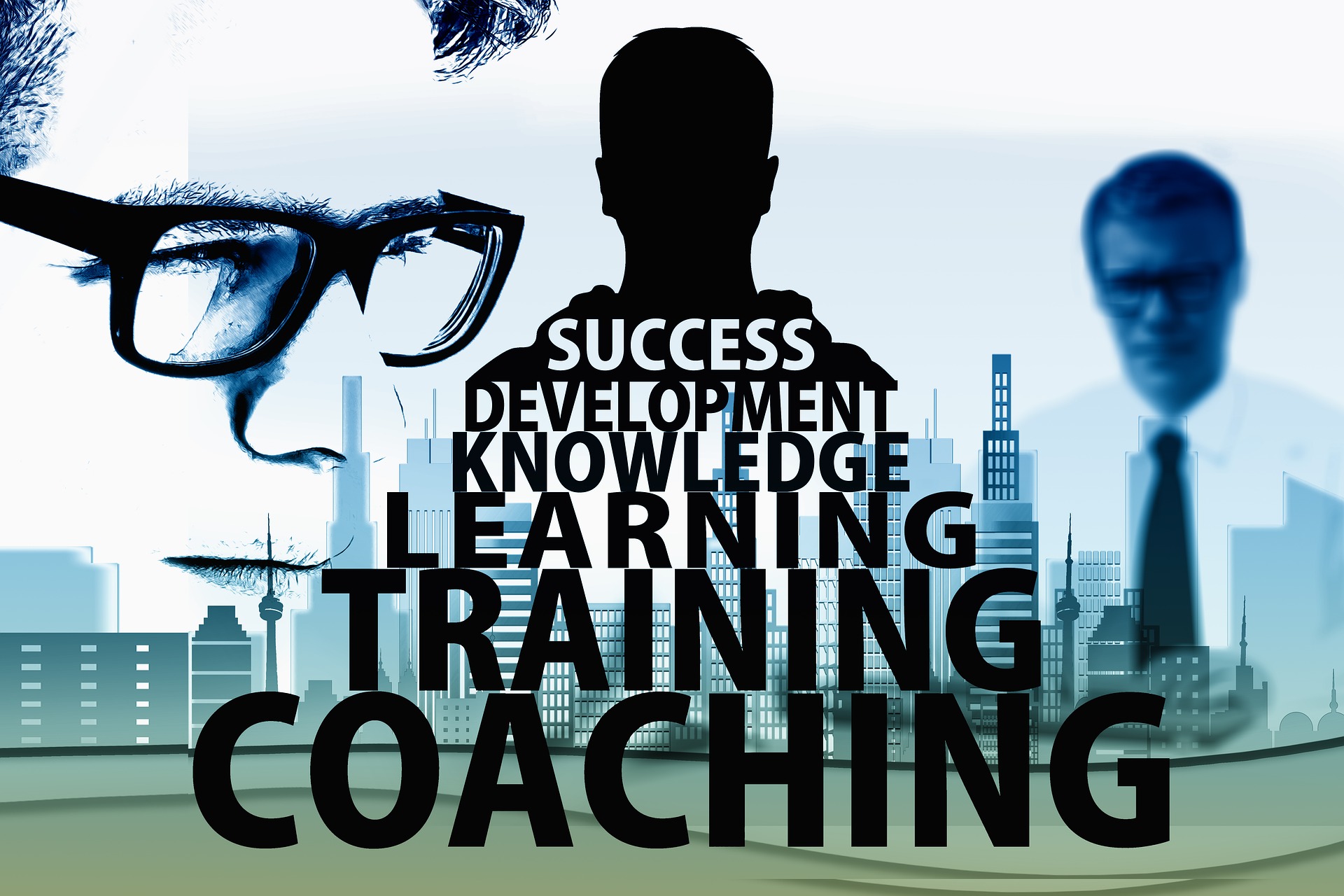Overview
We are well rounded and understand the training process from start to finish. Our Training Cycle provide you with a big picture of the process.
Anytime we participate in a training program, whether it is in a virtual or a traditional classroom, whether it was off-the-shelf or developed from scratch, whether it was taught by someone inside our organization or an external vendor, whether it was a program teaching management development skills or penetration testing skills, chances are that the program was designed by following a specific process.
The Training Cycle begins long before the training program is conducted and continues after the program has been completed. The figure below is a blueprint of the five phases of the Training Cycle.

Phase 1. Assess and analyze needs
This phase of the Training Cycle is called analysis. Generally, we need to conduct an assessment and analyze the data, to identify specific needs. There are two main reasons for completing an assessment and analysis.
- First, we want to make sure there is a reason to conduct training. We may discover that after conducting the analysis the relevant issue can be addressed by something other than training. For example, we may be able to do on-the-job coaching, online content may exist that could be delivered either asynchronously or synchronously, or we may feel that an article in the company newsletter alerts employees to the information needed.
- Second, if we do determine that training is necessary, the analysis should tell us exactly what (content) should be taught and how (by what methodology) it should be taught in the training session. It will also help determine our training objectives.
There are many ways to conduct assessments. we can use a formal instrument that measures a person’s skill or knowledge, or one that simply measures a person’s preference. we can use written questionnaires or we can use personal interviews with employees or supervisors. If we use interviews, we can meet with individuals one-on-one, or we can conduct small focus groups. Another way to assess a need is to observe an employee working or to take a work sample. We can also use records or reports that already exist, such as performance assessments
Our goal in collecting this data is to determine the gap between a job requirement and an individual’s actual skill or knowledge. Bottom line is to determine what is preventing the desired performance. we use this information in the next phase of the Training Cycle.
Phase 2. Develop objectives
After we have determined that there is a legitimate training need, our next step is to state exactly what we want the training to accomplish. We do this by writing objectives. There are two kinds of objectives from two perspectives used in training:
- The learning/performance objective: This is a statement of the performance (knowledge or skill) that is desired after the training has been conducted. Whether we call them learning or performance objectives doesn’t matter, as long as we realize that the purpose is to demonstrate what our participants have learned and can perform. What behavior changes did they make?
- The training objective: This is a statement of what the instructor hopes to accomplish during the training session. This may be an outcome, or it may be a description of what the instructor plans to do in order to accomplish the learning objectives. For example, “This session will create a positive learning climate that encourages participants to get involved and to ask questions.”
Some trainers include both learning and training objectives in their design. Learning objectives are a required step in every good training design. Training objectives help the trainer to focus on designing and delivering a first-class training program by setting targets for the trainer to achieve.
Learners are told what the learning objectives are at the beginning of a training session. And preferably at the same time they are told about the training.
Phase 3. Design and develop the program
After we determine the objectives, we can begin the program design. We decide exactly what we’re going to do to accomplish the objectives we set. There are many things to consider in designing a training program.
If we haven’t already, we will decide the type of delivery that will be the focus to achieve the best results: onsite classroom, virtual classroom, self-paced e-learning, performance support tools, self-study, or a combination of these and others in a blended learning solution. What questions will help determine the location of the training?
- How many participants need new knowledge and/or skills?
- Where are participants located?
- How much time is required?
- How much consistency is needed?
- When is training required?
- How many participants will be in each class?
- What level of trainer expertise will be required?
We may also decide whether to design the content at all. Given thousands of products available, we may decide instead to purchase pre-designed off-¬the-shelf content and customize it. we also build in methods to ensure that the learning is applied back on the job, and a process to evaluate the program’s effectiveness.
If we design it, a big task ahead of us is developing the materials. What participant materials do the learners need? What audiovisual materials and equipment will we use? If it is an online course, what technical support will we require? Will our learners require job aids — either paper or online? While this phase can be exciting, it can also be exhausting.
Phase 4. Implement the design
This is the Training Cycle phase where we actually conduct the program. A trainer completes a huge amount of preparation before the program. Even after an excellent job of preparing, there is no guarantee that the program will go off without a hitch. That’s why some trainers pilot a program with a group of pseudo-learners who provide feedback before the session is ready for prime time.
We use both presentation and facilitation skills in both a traditional and virtual classroom. As a trainer, we’re a presenter and a facilitator:
- Presenters provide more information. If much of the information is new or technical, we may need to present. The preferred role, however, is as a facilitator.
- Facilitators play more of a catalyst role and ensure learners’ participation. A good trainer is often synonymous with the term “facilitator.”
Excellent delivery skills are required whether we are facilitating a virtual or traditional classroom. While we’re conducting the training, we want to constantly read our learners to see whether we’re meeting their needs. If we see that an approach isn’t working, thus we stop and try another. We are not afraid to stray from the agenda if that seems to be the audience’s need. This is the phase where platform experience and good facilitation skills are required.
Phase 5. Evaluate performance
When it’s over, it’s not over. The evaluation phase is an important part of The Training Cycle for three reasons.
- First, the evaluation tells us whether or not the objectives were accomplished.
- Second, information from the evaluation phase should be fed into the assess-and-analyze phase. It is used to improve the training program should it be conducted again. This is why this model is circular.
- Finally, evaluation information serves as the basis for determining needs for future programs or other changes an organization may need to make.
Word of Advice
We start with the end in mind. It means that we start with the Evaluation phase. Our evaluation is part of the thought process as we begin the design at the Analysis phase.
To help us serve you better, please consider the following:
- What do you want to accomplish?
- What does your stakeholder expect?
- How will what is learned enhance your organization’s goals?
- What will success look like?
We exist to empower your organization by improving your current and future employees performance to increase their ability to perform through learning by increasing their skills and knowledge.

